
Ara is a southern constellation between Scorpius, Telescopium, Triangulum Australe, and Norma. It was one of the Greek bulk described by the 2nd-century astronomer Ptolemy, and it remains one of the 88 modern constellations designated by the International Astronomical Union.

The Carina Nebula or Eta Carinae Nebula is a large, complex area of bright and dark nebulosity in the constellation Carina, located in the Carina–Sagittarius Arm of the Milky Way galaxy. The nebula is approximately 8,500 light-years (2,600 pc) from Earth.

HD 93129 is a triple star system in the Carina Nebula, with all three components being hot O class stars amongst the most luminous stars in the Milky Way. It is the dominant member of the Trumpler 14 star cluster, a young star cluster within the Carina OB1 stellar association that harbors other super-luminous stars, like Eta Carinae and WR 25.

HD 93205, or V560 Carinae, is a binary stellar system, in the Carina Nebula in the constellation Carina. It consists of two massive O-stars that revolve around each other in 6 days.

Kappa Crucis is a spectroscopic binary star in the open cluster NGC 4755, which is also known as the Kappa Crucis Cluster or Jewel Box Cluster.

HD 93250 is a highly luminous hot blue binary star in the Carina Nebula in the constellation Carina.
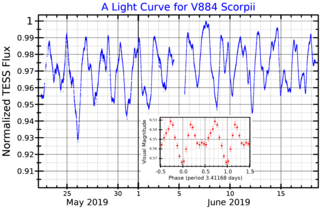
4U 1700-37 is one of the stronger binary X-ray sources in the sky, and is classified as a high-mass X-ray binary. It was discovered by the Uhuru satellite. The "4U" designation refers to the fourth Uhuru catalog.
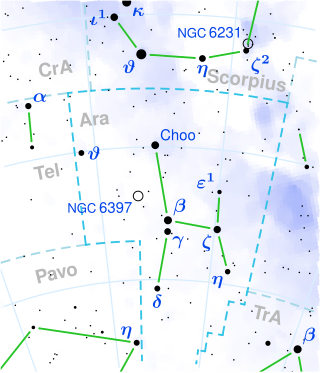
HD 150136 is a multiple star system in the southern constellation of Ara, around 4,300 light years away. It is the brightest member of the faint open cluster NGC 6193, part of the Ara OB1 association.

9 Sagittarii is a massive binary star in the constellation Sagittarius. It has an apparent magnitude of 5.97. Both components are highly luminous O-type main-sequence stars.

NGC 6604 is a young open cluster of stars in the equatorial constellation of Serpens, positioned about 1.5° north of the Eagle Nebula. The cluster was discovered by William Herschel on July 15, 1784. It is located at a distance of 4,580 light years from the Sun, about 210 ly (65 pc) above the galactic plane. NGC 6604 forms the densest part of the Ser OB2 association of co-moving stars.

WR 25 is a binary star system in the turbulent star-forming region the Carina Nebula, about 6,800 light-years from Earth. It contains a Wolf-Rayet star and a hot luminous companion and is a member of the Trumpler 16 cluster. The name comes from the Catalogue of Galactic Wolf–Rayet Stars.

Trumpler 16 is a massive open cluster that is home to some of the most luminous stars in the Milky Way galaxy. It is situated within the Carina Nebula complex in the Carina–Sagittarius Arm, located approximately 9,270 ly (2,842 pc) from Earth. The cluster has one star visible to the naked eye from the tropics southward, Eta Carinae.
HD 93403 is a spectroscopic binary containing two highly luminous hot blue stars. It is 10,000 light years away in the Carina Nebula in the constellation Carina. It appears to have spectral type O5.5III, but this is composed of two spectra from a blue supergiant and blue main sequence star of spectral type O5.5I and O7V respectively. The two stars orbit every 15 days with a separation that varies from 93 R☉ to 149 R☉. The binary is shedding mass at the high rate of 0.0005 M☉ per year.

HD 15558 is a massive O-type multiple star system in Cassiopeia and is specifically in our galaxy's Heart Nebula in the open cluster IC 1805. The primary is a very massive star with 152 M☉ and 660,000 L☉.

NGC 654 is an open cluster in the constellation Cassiopeia. It was discovered by William Herschel in 1787. With apparent magnitude 6.5, it can be observed by binoculars. It is located 2,5° northeast of the star Delta Cassiopeiae. In the same low power field can also be seen the open clusters NGC 663 and NGC 659. It surrounds a 7th magnitude yellowish star, an F5Ia supergiant, which is a possible member of the group.

HD 151932, also known as WR 78, is a Wolf-Rayet star located in the constellation Scorpius, close to the galactic plane. Its distance is around 1,300 parsecs away from the Earth. Despite being a blue-colored Wolf-Rayet star, it is extremely reddened by interstellar extinction, so its apparent magnitude is brighter for longer-wavelength passbands. HD 151932 lies about 22′ west of the open cluster NGC 6231, the center of the OB association Scorpius OB1; it is not clear whether it is a part of the association or not. With an apparent magnitude of about 6.5, it is one of the few Wolf-Rayet stars that can be seen with the naked eye.
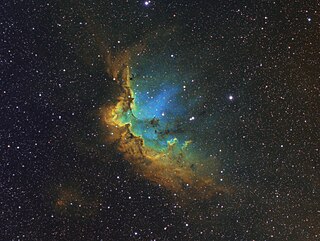
DH Cephei is a variable binary star system in the northern circumpolar constellation of Cepheus, positioned about two degrees to the east of the star system Delta Cephei. With an apparent visual magnitude of 8.61, it is too faint to be visible without a telescope. Based on parallax measurements, this system is located at a distance of approximately 9.6 kilolight-years from the Sun. At present it is moving closer to the Earth with a radial velocity of −33 km/s.
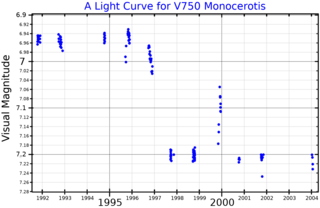
HD 53367 is a triple star system in the constellation of Monoceros. The primary star was identified as a variable Herbig Ae/Be star in 1989. Its companion, spectroscopically discovered in 2006, is a pre-main-sequence star star with an average separation of 1.7 AU. The star system is embedded in the extended nebula IC 2177.
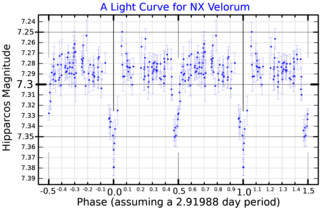
HD 73882 is a visual binary system with the components separated by 0.6″ and a combined spectral class of O8. One of stars is an eclipsing binary system. The period of variability is listed as both 2.9199 days and 20.6 days, possibly due to the secondary being a spectroscopic binary star.
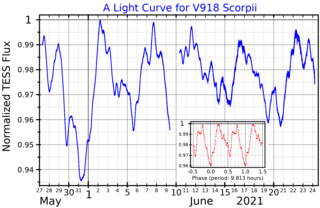
HD 149404, also known as HR 6164 and V918 Scorpii, is a star about 4,300 light years from the Earth, in the constellation Scorpius. It is a 5th magnitude star, so it will be faintly visible to the naked eye of an observer far from city lights. It is a rotating ellipsoidal variable, a binary star for which the two stars' combined brightness varies slightly, from magnitude 5.42 to 5.50, during their 9.8 day orbital period. It is one of the brightest members of the Ara OB1 association, which has the open cluster NGC 6193 at its center.



















